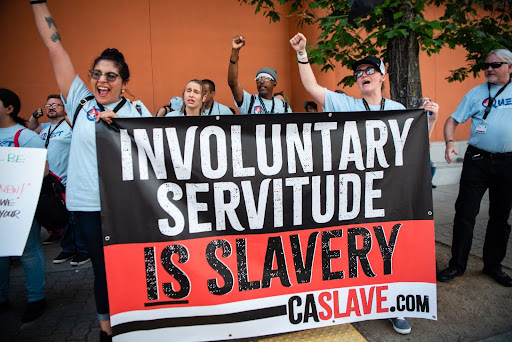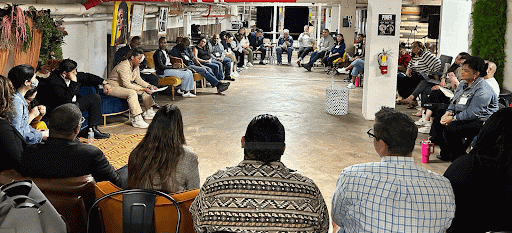It’s Time for Philanthropy to Include People with Disabilities
Communication is fundamental to our lives. It’s how we connect with each other and navigate society. Yet our ways of communicating often exclude the one-in-six adults in America with a sensory or communication disability, including people who are Deaf or hard of hearing, blind or low-vision, have speech or intellectual disabilities, and many more. To build a more inclusive and accessible world, we must commit to understanding their challenges and enacting the changes those most impacted by structural challenges recommend.
I know this because my children taught me.
I was working at the UN when my twin daughters were diagnosed with Autism and sensory processing disorders. While I was fighting to protect freedom of thought and expression internationally, at home, my children were unable to express their own thoughts. They are excluded by a society unwilling to truly listen and accommodate their different ways of communicating.
I now manage a grant program that serves people with any and all communication disabilities, improving access for Deaf, blind, neurodiverse, and other disabled communities. The access provided by projects we fund varies: it includes not only American Sign Language, captioning, and braille, but also text-to-speech on mobile devices, sensory deprivation rooms, and more. I have not found any other foundations that work exclusively to support the one-in-six people with communication disabilities. This shocking funding gap is partly explained by the history of ableism that runs through philanthropy.
A Legacy of Ableism in Philanthropy
Many of the founders of modern philanthropy, including Andrew Carnegie, Henry Ford, and Margaret Sanger, supported “solving” disabilities through eugenics. Sanger argued that traditional charitable care for disabled people demonstrated the “surest signs that our civilization has bred, is breeding and is perpetuating constantly increasing numbers of defectives, delinquents, and dependents.”1
While eugenics is now rightfully considered philanthropy’s “original sin,” foundations have continued to exclude and demean people with disabilities. Disabled community members have been exploited for years as objects of pity in tacky telethons. We still see this perpetuated through “inspiration porn” and fundraising campaigns portraying people with disabilities as heroic “others.”
The growing power of the disability justice movement, with its philosophy of “nothing about us without us,” focused the discussion on people with disabilities as agents of change informed by their lived experience. By 2006, the UN adopted the Convention on the Rights of Persons with Disabilities, recognizing that people with disabilities deserve equity and justice, not pity or charity.
COVID-19: Mass Disabling Event
However, the devastation caused by COVID revealed the fragility of this progress. The UN reports that “the COVID-19 pandemic has painfully shown that the old paradigm that existed … by which persons with disabilities are treated as if they are invisible or in ways that reinforce unequal power dynamics, is still alive.”
Businesses, schools, hospitals, and governments failed to accommodate people with disabilities. I know from my daughters’ experience that schools and other service providers dropped all pretense of providing necessary support for people with disabilities. For many with intellectual disabilities, increased dependence on virtual communication and limited resources from service providers meant isolation and misinformation. Statistics reveal the scale of the problem: intellectual disabilities were the strongest independent risk for COVID-19 diagnoses, and the leading risk factor, other than age, for COVID deaths.
The pandemic itself became a mass-disabling event, yet the response from foundations has shown that the understanding of how to build more inclusion and accessibility for disabled community members has not come far enough.
Philanthropy’s Role in Disability Access and Inclusion
Philanthropy remains part of an unequal power dynamic. People with disabilities continue to be overlooked by foundations. And as the UN report notes, “Invisibility can create inequality, and unequal treatment can itself lead to, or reinforce, invisibility.”
As foundations, we are responsible for creating meaningful change benefitting those who need it most. Don’t know where to start? Here’s what foundations can do to build equity for disabled communities:
- Make workplaces accessible for people with disabilities and deliberately recruit leaders and staff with disabilities.
- Make all your internal and external communications and meetings accessible.
- Fund disability projects. Remember that people with disabilities, including communication disabilities, intersect with multiple communities that funders already focus on.
- Require the inclusion of people with disabilities in projects designed for people with disabilities and require grantees to pay them for their participation.
- Make your application processes accessible.
If you are committed to doing better, consider joining the Disability Inclusion Pledge from the Disability & Philanthropy Forum.
Communication and information access are fundamental human rights. We can no longer deny philanthropy’s passive role in upholding barriers. It’s time for true inclusivity, actively creating space and belonging for people with disabilities at all levels of our organizations, learning from our mistakes, and moving toward a more equitable future for all of us.
Matt Cherry is the Director of Philanthropy at Ability Central. Before working in philanthropy, Matt spent 13 years as an executive director in the humanist movement. He served three terms as president of the United Nations NGO Committee on Freedom of Religion or Belief.
Ability Central serves as an educator, convener and resource that works collaboratively to ensure communication and information access in service of individuals who are Deaf, disabled, and neurodiverse.



